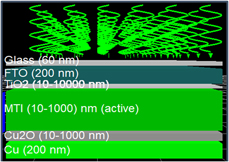Crossref Citations
This article has been cited by the following publications. This list is generated based on data provided by
Crossref.
Tang, Yiran
Tao, Yuwei
Wang, Qing
Zhu, Zerui
Zhang, Wanqi
Li, Xiang
Xie, Aijuan
and
Luo, Shiping
2019.
Mesoporous double-perovskite LaAMnNiO6 (A = La, Pr, Sm) photothermal synergistic degradation of gaseous toluene.
Journal of Materials Research,
Vol. 34,
Issue. 20,
p.
3439.
Islam, Md Tohidul
Jani, Md Rafsun
Al Amin, Syed Muhammad
Sami, Md Shifat Us
Shorowordi, Kazi Md
Hossain, Mohammad Istiaque
Devgun, Mohan
Chowdhury, Shaestagir
Banerje, Sankha
and
Ahmed, Saquib
2020.
Numerical simulation studies of a fully inorganic Cs2AgBiBr6 perovskite solar device.
Optical Materials,
Vol. 105,
Issue. ,
p.
109957.
Deepthi Jayan, K.
and
Sebastian, Varkey
2021.
Modelling and comparative performance analysis of tin based mixed halide perovskite solar cells with
IGZO
and
CuO
as charge transport layers
.
International Journal of Energy Research,
Vol. 45,
Issue. 11,
p.
16618.
Islam, Md. Tohidul
Jani, Md. Rafsun
Rahman, Sanzida
Shorowordi, Kazi Md.
Nishat, Sadiq Shahriyar
Hodges, Deidra
Banerjee, Sankha
Efstathiadis, Harry
Carbonara, Joaquin
and
Ahmed, Saquib
2021.
Investigation of non-Pb all-perovskite 4-T mechanically stacked and 2-T monolithic tandem solar devices utilizing SCAPS simulation.
SN Applied Sciences,
Vol. 3,
Issue. 4,
Jiang, Mengying
and
Tang, Jiyu
2021.
Simulated development and optimized performance of narrow-bandgap CsSnI3-based all-inorganic perovskite solar cells.
Journal of Physics D: Applied Physics,
Vol. 54,
Issue. 46,
p.
465104.
Jiang, Mengying
and
Tang, Jiyu
2021.
Numerical simulation design of all-inorganic hole-transport-layer-free CsSnI3 (Sn-rich)/CsSnI3 perovskite efficient solar cells.
Journal of the Optical Society of America B,
Vol. 38,
Issue. 12,
p.
3754.
Fan, Xiaojuan
2022.
Flexible dye-sensitized solar cells assisted with lead-free perovskite halide.
Journal of Materials Research,
Vol. 37,
Issue. 4,
p.
866.
Amjad, Akfeen
Qamar, Samina
Zhao, Chengchen
Fatima, Kalsoom
Sultan, Muhammad
and
Akhter, Zareen
2023.
Numerical simulation of lead-free vacancy ordered Cs2PtI6 based perovskite solar cell using SCAPS-1D.
RSC Advances,
Vol. 13,
Issue. 33,
p.
23211.
Rani, Rekha
Monga, Kamil
and
Chaudhary, Shilpi
2023.
Simulation of efficient Sn/Pb-based formamidinium perovskite solar cells with variation of electron transport layers.
Physica Scripta,
Vol. 98,
Issue. 7,
p.
075910.
Dikhit, Arati
and
Kumar Tripathy, Sukanta
2024.
Enhancing the solar cell efficiency with Azetidinium based Perovskites: An investigation for device optimization using DFT and SETFOS.
Solar Energy,
Vol. 284,
Issue. ,
p.
113089.
Yasir, Hafiz Noman
Bano, Nargis
Farhadi, Bita
Hussain, Ijaz
and
Zulfiqar, Muhammad
2025.
Design and performance enhancement of all perovskite based 2T monolithic tandem solar cell: A numerical simulation approach.
Inorganic Chemistry Communications,
Vol. 177,
Issue. ,
p.
114339.
